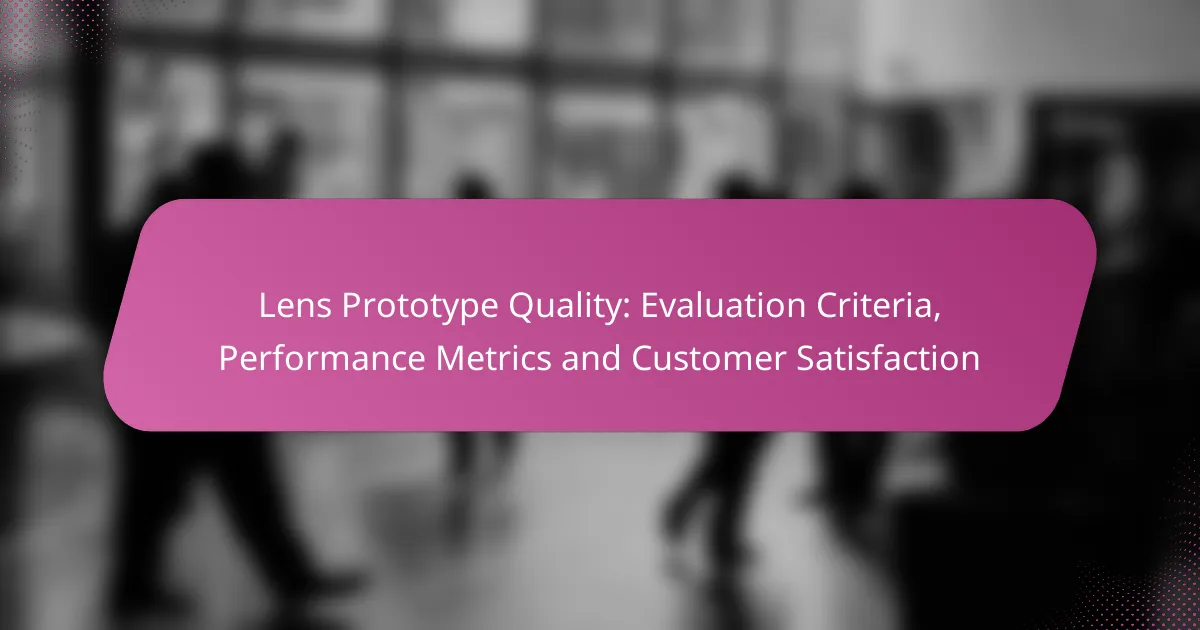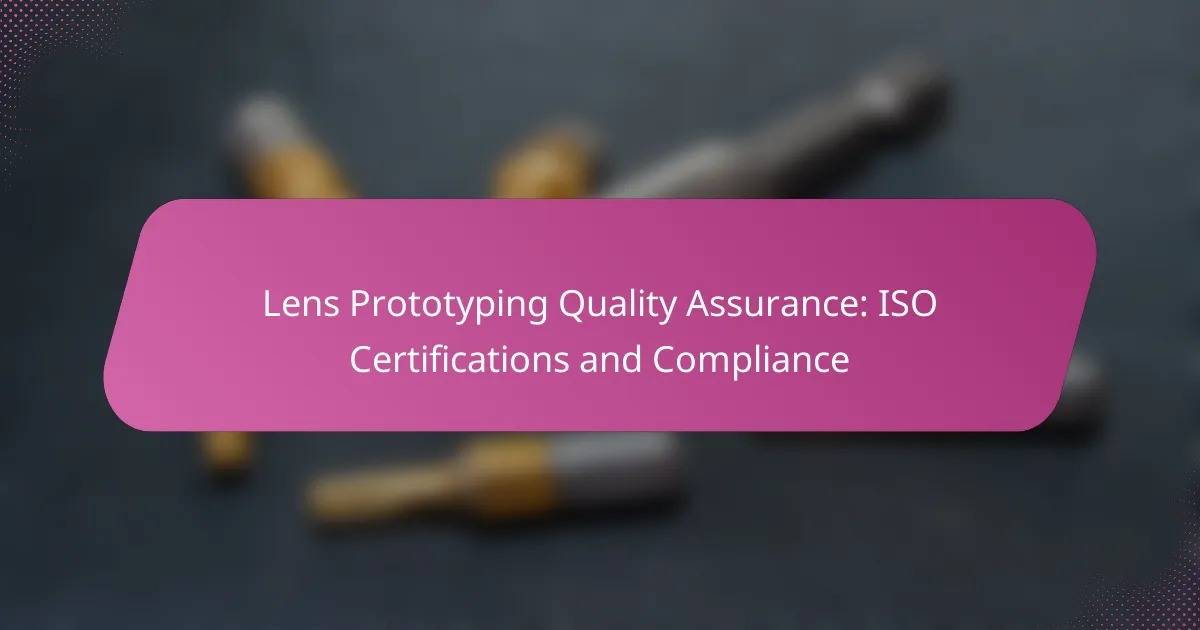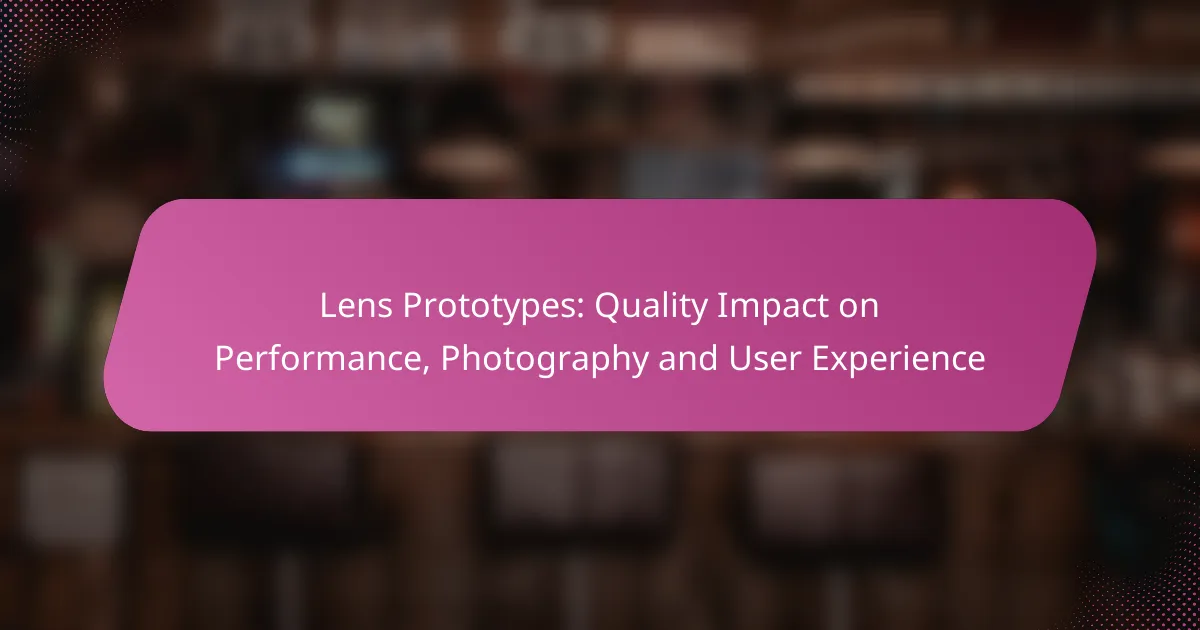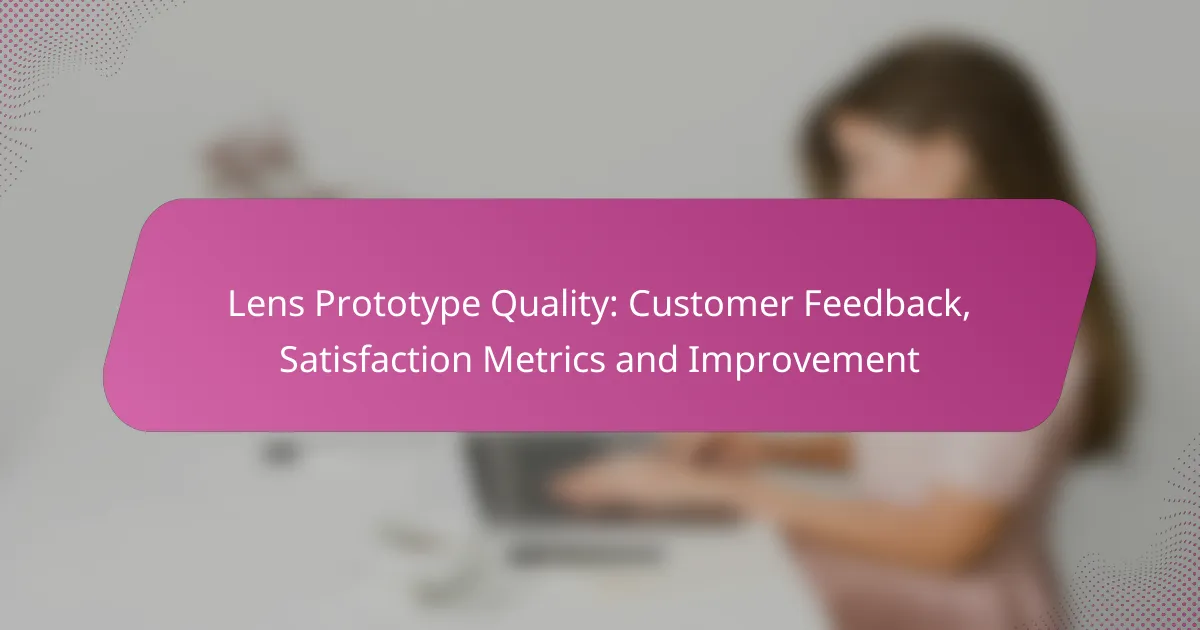Evaluating lens prototypes involves a comprehensive analysis of performance metrics that assess their optical clarity, durability, and cost-effectiveness. These criteria are essential for ensuring that the prototypes meet specific application needs and align with customer expectations. Additionally, customer satisfaction is shaped by usability, comfort, and support, highlighting the importance of a holistic approach in the development process.
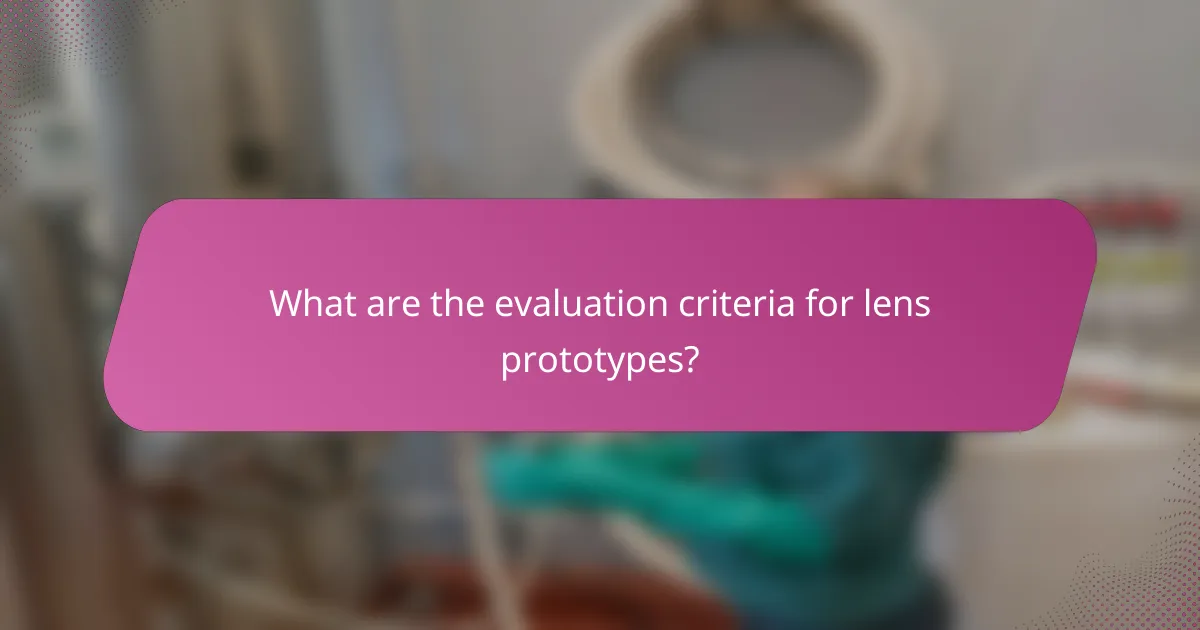
What are the evaluation criteria for lens prototypes?
The evaluation criteria for lens prototypes focus on key performance metrics that determine their effectiveness and suitability for specific applications. These criteria include optical clarity, durability, weight, cost-effectiveness, and compatibility with existing systems.
Optical clarity
Optical clarity is crucial for lens prototypes as it directly affects the quality of vision. High optical clarity ensures minimal distortion and maximum light transmission, which is essential for applications like photography and vision correction. When evaluating clarity, look for lenses that meet industry standards such as ISO 12312-1 for sunglasses or similar specifications for other types of lenses.
To assess optical clarity, consider performing visual tests or using optical measurement tools. A common heuristic is that lenses should have a light transmission rate of over 90% for optimal performance.
Durability
Durability refers to a lens prototype’s ability to withstand physical stress and environmental factors without degrading. This includes resistance to scratches, impacts, and temperature variations. Materials such as polycarbonate or high-index plastics are often preferred for their robust properties.
When evaluating durability, consider conducting drop tests or scratch resistance tests. Look for lenses that comply with ASTM standards for impact resistance, ensuring they can endure typical usage conditions.
Weight
Weight is an important factor, especially for wearable lenses like glasses or goggles. Lighter lenses enhance comfort and reduce fatigue during prolonged use. Aim for lenses that weigh no more than a few grams per square centimeter, depending on the application.
To find the right balance, compare the weight of different materials. For instance, glass lenses tend to be heavier than polycarbonate, which may be more suitable for active use cases.
Cost-effectiveness
Cost-effectiveness evaluates the balance between the price of lens prototypes and their performance benefits. While cheaper options may be tempting, they often compromise on quality, leading to higher long-term costs due to replacements or dissatisfaction.
When assessing cost-effectiveness, calculate the total cost of ownership, including maintenance and replacement rates. Aim for lenses that offer a good performance-to-price ratio, typically within a range of 20-30% of the total budget for optical equipment.
Compatibility with existing systems
Compatibility with existing systems ensures that lens prototypes can integrate seamlessly with current technologies or devices. This is particularly important in fields like photography, where lenses must fit specific camera mounts or optical systems.
To evaluate compatibility, check the specifications of your existing equipment and ensure that the lens prototypes meet those requirements. Consider factors like mounting types, focal lengths, and sensor sizes to avoid compatibility issues that could hinder performance.
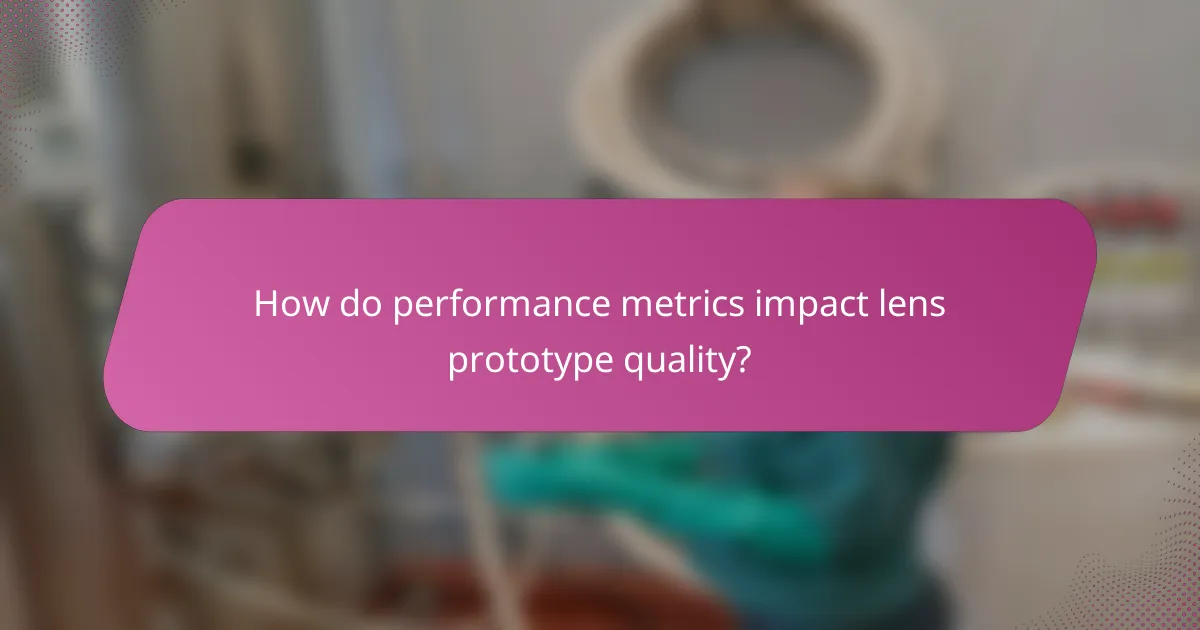
How do performance metrics impact lens prototype quality?
Performance metrics are crucial for assessing lens prototype quality, as they directly influence the optical characteristics and user experience. By evaluating these metrics, manufacturers can identify strengths and weaknesses in their designs, ensuring that the final product meets customer expectations.
Resolution and sharpness
Resolution and sharpness are fundamental metrics that determine how clearly a lens can render images. High-resolution lenses can capture fine details, making them essential for applications like photography and microscopy. A good rule of thumb is to aim for a resolution that exceeds the pixel density of the intended display or sensor.
When evaluating resolution, consider the lens’s MTF (Modulation Transfer Function) curve, which indicates how well the lens can reproduce contrast at various spatial frequencies. A higher MTF value at higher frequencies generally correlates with better sharpness.
Color accuracy
Color accuracy measures how faithfully a lens reproduces colors compared to a reference standard. This metric is vital for applications where color fidelity is essential, such as in graphic design and medical imaging. Lenses that exhibit high color accuracy will have minimal chromatic aberration and consistent color reproduction across different lighting conditions.
To assess color accuracy, look for lenses that adhere to established color standards, such as sRGB or Adobe RGB. Additionally, consider using color calibration tools to evaluate how well the lens performs in real-world scenarios.
Light transmission
Light transmission refers to the amount of light that passes through a lens, impacting its brightness and clarity. High light transmission is crucial for low-light conditions, as it allows more light to reach the sensor or eye. Generally, a light transmission rate above 90% is desirable for most applications.
When evaluating light transmission, consider the lens coatings used, as they can significantly enhance performance. Anti-reflective coatings, for example, can reduce glare and improve overall light transmission, making the lens more effective in various environments.
Distortion levels
Distortion levels indicate how much a lens deviates from a rectilinear projection, affecting the accuracy of the image. Common types of distortion include barrel and pincushion distortion, which can lead to noticeable image warping. For high-quality lenses, distortion should be minimized, ideally below a few percent.
To evaluate distortion, use test charts or software that can analyze images taken with the lens. Understanding the type and degree of distortion will help in selecting the right lens for specific applications, especially in architectural photography or any field where straight lines are critical.

What factors influence customer satisfaction with lens prototypes?
Customer satisfaction with lens prototypes is influenced by usability, comfort, customer support, brand reputation, and feedback. These factors collectively shape the overall experience and perception of the product.
Usability and comfort
Usability and comfort are critical for customer satisfaction with lens prototypes. Users expect lenses to fit well and be easy to use, which directly affects their daily experience. A comfortable fit can enhance wear time, while usability ensures that the lenses can be handled and inserted without difficulty.
When evaluating prototypes, consider the weight, flexibility, and moisture retention of the lenses. For instance, lightweight materials often lead to higher comfort levels, while moisture-wicking features can enhance usability by reducing dryness.
Customer support and service
Effective customer support and service significantly impact satisfaction with lens prototypes. Quick response times and knowledgeable representatives can help resolve issues, making customers feel valued and understood. A strong support system can turn a negative experience into a positive one.
Offering multiple channels for support, such as phone, email, and live chat, can enhance accessibility. Additionally, providing clear instructions and resources for troubleshooting can empower customers to resolve minor issues independently.
Brand reputation
Brand reputation plays a vital role in customer satisfaction with lens prototypes. Established brands often benefit from trust and credibility, which can influence purchasing decisions. Customers are more likely to choose lenses from brands known for quality and reliability.
To build a strong reputation, companies should focus on consistent product quality and transparency in their manufacturing processes. Engaging in ethical practices and sustainability can also enhance brand perception among environmentally conscious consumers.
Feedback and reviews
Feedback and reviews are essential for understanding customer satisfaction with lens prototypes. Positive reviews can boost confidence in a product, while negative feedback can highlight areas for improvement. Customers often rely on the experiences of others when making purchasing decisions.
Encouraging customers to leave reviews can provide valuable insights. Companies should actively monitor feedback and address concerns promptly, demonstrating a commitment to customer satisfaction and continuous improvement.
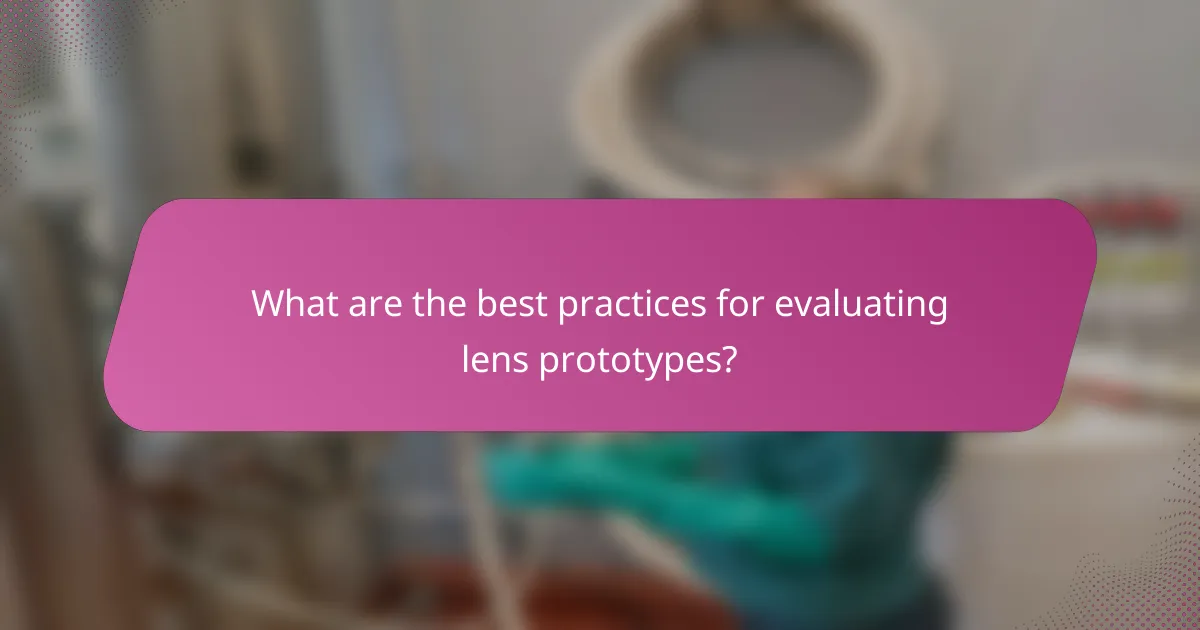
What are the best practices for evaluating lens prototypes?
Evaluating lens prototypes effectively involves a combination of standardized testing and real-world field testing with end-users. These practices ensure that the lenses meet performance metrics and customer satisfaction criteria.
Standardized testing procedures
Standardized testing procedures are essential for objectively assessing lens prototypes. These tests typically include optical performance evaluations, durability assessments, and comfort measurements. For optical performance, metrics such as light transmission, distortion, and color accuracy are commonly analyzed.
When conducting durability assessments, consider factors like scratch resistance and impact resistance, often measured against industry standards. Comfort measurements can involve subjective feedback from testers regarding weight, fit, and overall wearability, which can be quantified through surveys or scales.
Field testing with end-users
Field testing with end-users provides invaluable insights into how lens prototypes perform in real-world conditions. This testing phase allows users to evaluate the lenses during typical activities, such as driving, sports, or daily wear. Collecting feedback during this phase helps identify potential issues that standardized tests may not reveal.
To maximize the effectiveness of field testing, select a diverse group of testers that represent your target market. Encourage them to provide detailed feedback on aspects like visual clarity, comfort over extended use, and any challenges faced during specific tasks. This qualitative data is crucial for refining the prototypes before final production.
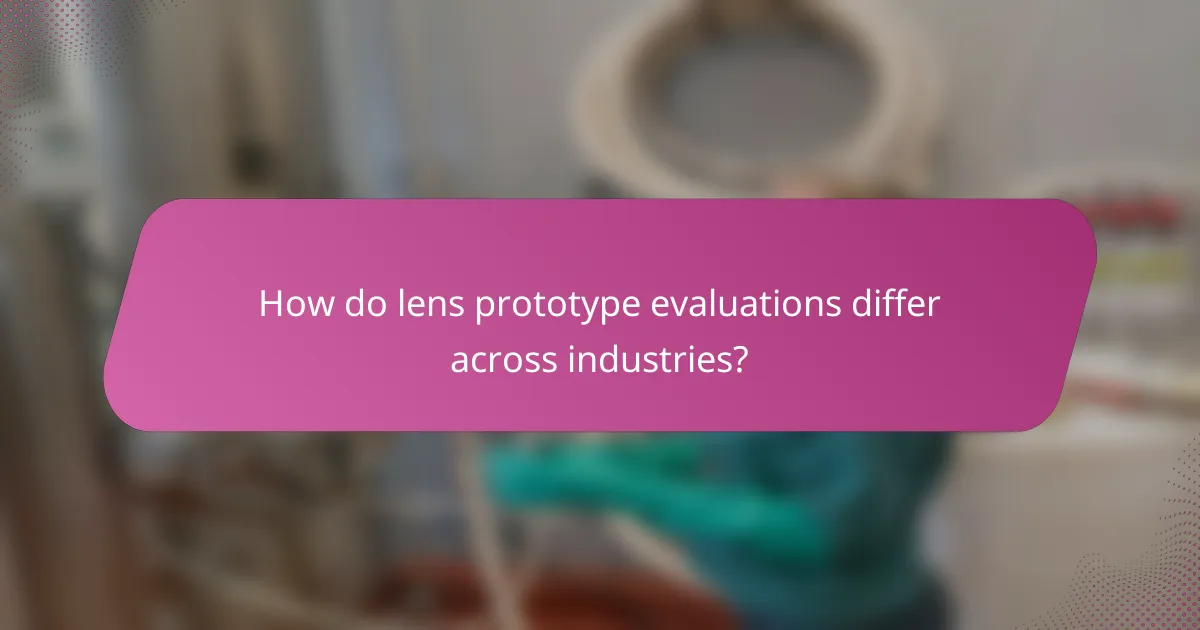
How do lens prototype evaluations differ across industries?
Lens prototype evaluations vary significantly across industries due to differing performance requirements, regulatory standards, and customer expectations. Each sector prioritizes specific metrics that align with its unique applications and end-user needs.
Medical vs. consumer optics
In the medical optics field, lens prototypes must meet stringent regulatory standards, such as those set by the FDA in the United States or the CE marking in Europe. These lenses are often evaluated for precision, durability, and biocompatibility, as they are used in critical applications like surgical instruments and diagnostic devices.
Conversely, consumer optics focus more on user experience and aesthetic appeal. Evaluation criteria may include clarity, color accuracy, and comfort for everyday use in products like eyeglasses or cameras. While performance is important, factors such as price and brand reputation also play a significant role in consumer satisfaction.
Aerospace vs. automotive applications
Aerospace lens prototypes are subjected to rigorous testing for factors such as weight, thermal stability, and resistance to environmental stressors. These lenses must comply with strict aerospace standards, ensuring they can withstand extreme conditions while maintaining optical performance.
In automotive applications, lens evaluations prioritize safety and visibility. Prototypes are tested for clarity, scratch resistance, and the ability to perform under various lighting conditions. Compliance with automotive regulations, such as those from the National Highway Traffic Safety Administration (NHTSA) in the U.S., is crucial for ensuring that lenses meet safety standards for vehicles.
